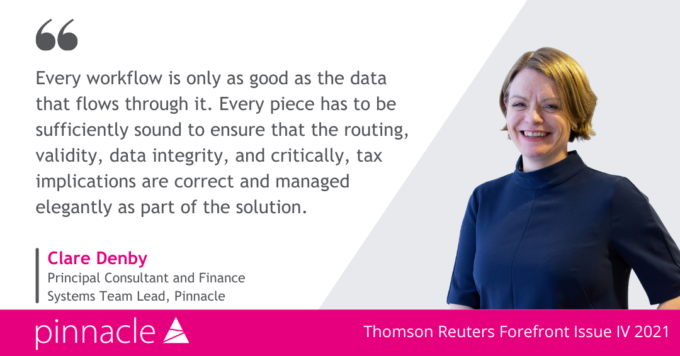
Clare Denby, Principal Consultant and Finance Systems Team Lead at consulting group Pinnacle, knows that more secure tax management is there for the taking in 3E – but you need to look beyond the workflow.
The last two years have seen some necessarily seismic shifts in the approach to remote, efficient working. I’ve been working in the legal industry for over 20 years, and the shift for law firms to accept, have confidence in, and even encourage more remote working is huge. For a lot of firms, before Covid, the technical systems were in place to allow this, but the confidence was not. As I write this article, we’re at a stage where this is being challenged because the health necessity to work remotely is decreasing, so it remains to be seen how much is normalized moving forward.
However, a necessary implication which we have been seeing in the consulting arena is a definite drive to implement more efficient electronic business process workflows. It feels like whatever happens, this is only going to increase as it accommodates any type of working situation.
Adopting a more decentralized and electronic business process approach to billing is a common requirement and a key consideration for a number of firms of any size that we have been working with over the last few years. The workflow is the glamour side of it; but it’s the more gritty underbelly we need to concern ourselves with, the data. Every workflow is only as good as the data that flows through it. Every piece has to be sufficiently sound to ensure that the routing, validity, data integrity, and, critically, tax implications are correct and managed elegantly as part of the solution.
So, now we get to the detail where I get excited!
From my perspective, the Country of a client, the beneficiary of services becomes critical. It allows us, in 3E, to be more sophisticated and use the Tax Area Matrix to determine the tax status of the invoice, in relation to the jurisdiction from which the invoice is issued (Billing Office/Tax Area From) in relation to the client/beneficiary of the services (Payor Address/Tax Area To) rather than rely on a user determining the correct tax code to assign to the matter. My strong recommendation is to make the country field on the Site of the entity a required field so that the address of any entity in the system has a valid country. This is also beneficial to identify intervention tax requirements where the comparison of the billing address of the legal entity v location of service of the client aligned with the timekeeper location can have an intervention implication. This data integrity allows us to more easily identify these scenarios and also provide better business intelligence in reports on what services the firm delivers to different jurisdictions.
And this is where the effort comes in: having clean data in your system requires you to make this a conscious and continuous consideration at every stage of the process, not to approach it as a one-off or occasional activity.
- The conversion can generally only do so much in terms of translating the data if the legacy information isn’t provided in a structured way.
- Post-conversion data cleansing – now the data can be formatted more efficiently in 3E, the data cleansing is often left behind in the rush to get used to the new system.
- Once the data is cleansed, you need to have processes in place to ensure that it is maintained.
In our projects, we put these three areas of consideration especially high on the list with
- Clients who are transitioning from legacy systems where the address information may not be formally structured
- Clients who are merging/acquiring firms to bring their data into the existing system where the address information may not be formally structured
- Clients who haven’t historically had good controls over Master data generally.
Though I have made it sound like a lot of hard work, which to some extent it is, the good news is that there are a number of tools available that can facilitate this critical data element, including a number of applications we developed in line with our experience such as Address Quality Manager and Entity Merge. They may fall shy of ‘magic wand’ status, but they’re capable of a huge amount of heavy-lifting – saving time, money, risk and stress, and taking pressure off at critical points in the workstream.
If the last couple of years has proven anything, it’s that it’s not easy to guess right as to how things are going to play out. But I can be certain of one thing: firms will always need to work on their data, and they’d be wise to leverage the tools that can make light work of that challenge.
Clare Denby | clare.denby@pinnacle-oa.com
Clare Denby has over 20 years of global consulting experience working largely with multi-national firms on implementations of both Enterprise and 3E. She is widely regarded as one of the foremost 3E application consultants in EMEA, with stand-out technical and business process knowledge and a prodigious ability to manage highly complex, challenging workstreams.
This article first appeared in Forefront Issue IV – you can read it here
